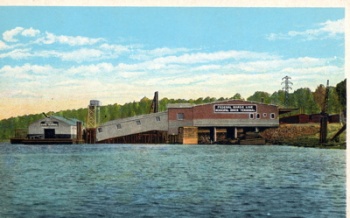Encyclopedia Dubuque
"Encyclopedia Dubuque is the online authority for all things Dubuque, written by the people who know the city best.”
Marshall Cohen—researcher and producer, CNN
Affiliated with the Local History Network of the State Historical Society of Iowa, and the Iowa Museum Association.
SOUTH PORT
SOUTH PORT. Bordered by East First Street to the north, Highway 151 on the west and a short distance south of the JULIEN DUBUQUE BRIDGE, and the filled-in area extending to the MISSISSIPPI RIVER, "South Port" has been a primary site for change--business and environmental. (1)
Dubuque's South Port since the 1870s was a maze of roadways, railroad right-of-ways and businesses. Carr and Austin planing mills supplied lumber yards north of the ILLINOIS CENTRAL RAILROAD roundhouse. The RYAN PACKING COMPANY was located between Water and Levee STREETS near Jones. A coal yard, perhaps used by the railroad roundhouse and steamers moored at the levee, was located between Levee (now Terminal Street) and Water streets. A public levee and wharf ran parallel to Levee Street. The DIAMOND JO LINE was granted permission to use a portion of the public levee around 1892. Avenues were raised to lift them above the sloughs which were gradually filled. (2)
On October 13, 1926, W.W. Morse, vice president and general manager of the Upper Mississippi Barge Line headquartered in Minneapolis, Minnesota, met with members of the Dubuque Chamber of Commerce. Morse explained that shippers in Minneapolis and St. Paul were interested in river traffic. Between 1920 and 1926, the cost of rail car lot shipments had increased as much as 200 percent. The Minneapolis businessmen believed the use of the river would free the area from the freight rates which were handicapping agriculture, manufacturing and business. (3)
Morse suggested that Dubuque was the logical transfer point for shipments going to and from Chicago and the Twin Cities. A great amount of rail and water traffic for shippers from the area west of Dubuque would be routed by way of the city. The problem for Dubuque was that the government required a satisfactory terminal. Dubuque had no dock or loading ramp for barges. Problems at the levee made unloading difficult. (4)
On October 14, 1926, the Dubuque City Council took official action authorizing a special city election on the the day of the general election that year, November 2, on the following question:
Shall the city council of the City of Dubuque
be authorized to create a department to be known
as the department of public docks?
After approval of the question by the residents (6,732 to 2,970), the city council authorized representatives of the city to accompany representatives of the Chamber of Commerce, the Dubuque Shippers' Association and the press of the city on a trip of the lower Mississippi River to inspect terminals and barge line activities in St. Louis and New Orleans. This tour began on October 16, 1926. The members of the touring committee found various terminals along the river busy with commerce. They were also told that population growth in the thousands could be expected for a city located at a terminal. (5)
Based on the tour and election, conditions were studied and it was decided to form a corporation to construct and operate a barge line on the upper MISSISSIPPI RIVER. Minneapolis contributed $72,000, St. Paul $48,000, Dubuque $5,000 with other cities along the river contributing various amounts. Finally a contract was written with the federal government's Inland Waterways Corporation. (6)
The city council named John A. KERPER and P.S. Fawkes, two of the people who had been involved in the tour, and Louis Brede, a former city commissioner, to the first dock commission. This commission determined the kind of terminal to be erected and directed the work in South Port to completion. C.J. Hoffman and L.E. Moore were the first terminal superintendent and chief clerk respectively. (7)
The FEDERAL BARGE LINE began service between St. Louis and Minneapolis in 1927. The barge in Dubuque opened that year at the end of Jones Street. When the terminal was completed from two to six barges could be unloaded at one time. Two tow motors, hauling from one to five five of the 30 two-ton loading and unloading trucks were used for the lighter loads. Heavier freight was moved by an eighteen-ton crane and a specially designed runway south of the terminal. (8)
Around 1938 the Dock Board, with financial aid from the Works Progress Administration, constructed a trestle for freight cars to reach the docks of the Municipal Barge Lines Terminal. (9)
---
Source:
1. Meyer, Jeff. "Years of Activity," Telegraph Herald, January 6, 2017, p. 6A
2. Ibid. p. 7A
3. Ibid.
4. Kruse, Len. "The Federal Barge Line," My Old Dubuque. Center for Dubuque History, Loras College, Dubuque, Iowa 2000 p. 232-236
5. Ibid.
6. Ibid.
7. Ibid.
8. Ibid.
9. Meyer, p. 7A


